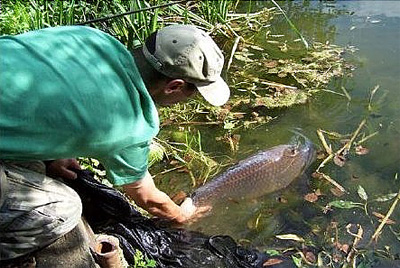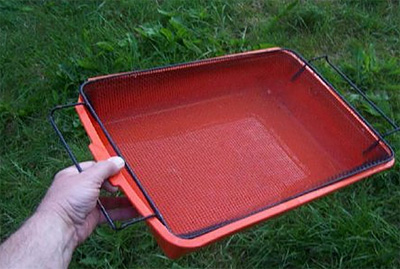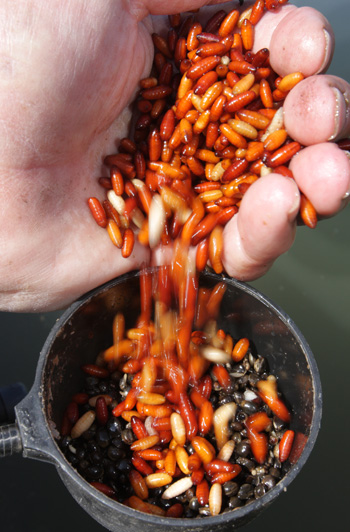Maggots were, for a very long time, the favourite bait of most anglers; nearly every angler used them on a regular basis and they were usually the first line of attack on most waters. These days the ‘modern’ angler can use a much more hi-tech, high nutrient approach and while the likes of boilies and pellets certainly have a place in modern angling the humble maggot is still just as effective as it ever was, and can be even more deadly if used to best advantage.
There are basically four types of maggot: squats, pinkies, gozzers and the common or garden ‘maggot’
Squats
Squats are very small maggots that can be used in several interesting ways; for example they are ideal for catching very small fish on light gear as one might in a hard match in the depths of winter or there are a great addition to groundbait if you want to start fish ‘picking’ and looking for larger, tastier morsels. Squats have the singular quality that once in the water they just lie on the bottom motionless and will not dig into the silt or gravel as maggot or pinkies can do.
Squats are the larva of the common house fly.
Pinkies
Pinkie are smaller than maggots but slightly bigger than squat and are often used in conjunction with squat as the hook bait, while feeding squats. Squats and pinkies are favourites with match anglers as they are a super bait for scratching for small fish such as gudgeon, bleak or small roach. Alternatively, if used with a light groundbait, a sizable bag of skimmers or bream can be achieved in quick time.
Pinkies are very much softer than maggots and this is possibly an advantage in certain conditions.
Pinkies are the larva of the greenfly.
Gozzers
Gozzers are a large, very soft maggot that are specially produced by allowing the Greenfly to ‘blow’ on the heart of pigs or sheep and as such they are only produced in small quantities and are quite expensive, if indeed you can source them at all. Many matchmen used to produce their own, although it has to be said that the process is quite unpleasant.
Maggots
Countless millions of maggots have been put in our rivers and lakes, fish know what they are – and they like them! There is not a single species of freshwater fish that has not been caught on a maggot some, I will grant you, only very rarely but at the other extreme some can be induced to feed on maggots in a frenzy. I have seen barbel nosing a house brick to one side just to see if there were any maggots underneath it and if fed properly they can produce the sort of feeding behaviour that makes your mouth water. That said they are expensive and can be difficult to store, but with a little effort you can improve your bait, keep it longer and increase your chances by enhancing that which you have already paid for.
 Maggots are living baits and while you would think that one maggot is the same as another a quick study can give you some useful information. When you buy your pint of maggots each grub should have a black mark, which is easily visible as you look at them. This is the stomach and it contains the remains of the maggot’s last feed, you can age a maggot using this spot because as the maggot gets older the spot reduces in size until it disappears – it is at that stage that the maggot starts to pupate and turn into a caster.
Maggots are living baits and while you would think that one maggot is the same as another a quick study can give you some useful information. When you buy your pint of maggots each grub should have a black mark, which is easily visible as you look at them. This is the stomach and it contains the remains of the maggot’s last feed, you can age a maggot using this spot because as the maggot gets older the spot reduces in size until it disappears – it is at that stage that the maggot starts to pupate and turn into a caster.
Maggots can be bred on any number of carcasses from cattle and sheep to chickens and fish and indeed where they are bred will affect what they are like. Maggots bred on beef tend to be tougher skinned while those bred on fish can be softer and more watery; most of the grubs that you get from tackle shops these days are bred on either fish or chicken carcases.
The meat is hung in a shed and the ‘Zoomers’, or blow flies, are allowed to lay their eggs on it; as you can imagine this is a very controlled environment where only one species of fly is allowed near the meat and in the case of ‘ordinary’ maggots it is a specially bred bluebottle. Once the carcases are ‘blown’ the eggs develop into grubs that will eat only until they reach their full size, they then drop into a sawdust pan where they are collected and shipped off to the tackle shop.
Once at the shop they must be riddled and added to fresh sawdust before being placed in a refrigerator. Maggots are supplied in gallon containers and the Brownian Motion of 32,000 maggots (there are roughly 4,000 maggots to a pint) creates a lot of heat so a quick way to cool them down is to splash a handful of cold water in each gallon container – once they have been given a ‘drink’ it is into the fridge with them.
Prior to sale the maggots are riddled again and it is at this point that all of the waste, such as bits of feather small bones, are removed; this often requires repeat riddling before the maggots are placed into a fresh pan of sawdust. After this the maggots are riddled yet again and then maize meal is usually added to give the dusty ‘fresh’ appearance that you see at the point of sale.
Maggots last longer if kept cold so it is always a balancing act to keep them cool enough that they last longer and yet warm enough that they can easily be riddled. Maggots look better when kept in maize meal but in fact they sink better, and are less greasy, if kept in sawdust. Sawdust makes the skin tougher though, so you pays your money and…
Once you have purchased your maggots the best thing to do is keep them in a refrigerator but after a day’s fishing they often become greasy and smelly and can be a bit warm. Many anglers throw them away at this stage thinking they are not worth keeping but if you are careful, and are prepared to put in a little effort, then you need never waste another maggot again.
 What you need is a cat litter tray (two are better) and a large riddle – mine was a fiver, an old towel, a bag of sawdust, an atomiser to spray water, a brush from a dustpan set and a thin sheet of plastic – that when wobbled makes you think of Rolf Harris…
What you need is a cat litter tray (two are better) and a large riddle – mine was a fiver, an old towel, a bag of sawdust, an atomiser to spray water, a brush from a dustpan set and a thin sheet of plastic – that when wobbled makes you think of Rolf Harris…
Take the smelly old maggots and riddle off the old dust by simply moving the riddle vigorously and pouring a small quantity of maggots at a time onto it; the dust will fall through and the maggots will bounce around on the riddle. Pour the cleaned maggots into the cat litter tray and keep this up until all of them have been sieved, then give them a spray of water from the atomiser to cool them down.
If the maggots are smelly then simply wash them! We know that the maggot has eaten so obviously it will also need to excrete and what it excretes is an ammonia solution (it is actually this smell that the blow flies often home in on, not the smell of rotten meat. Maggots much prefer to eat fresh meat that is just turning, rather than meat that is already rotting). To remove the ammonia pour fresh water into the cat litter tray with the maggots and swirl them about in the water then drain off the water by pouring the maggots into the riddle. Dump several handfuls of fresh sawdust into the cat litter tray and add the wet maggots, mix the two together and then sieve off the wet sawdust as previously described until the maggot are dry. Then it’s simply a case of adding fresh sawdust and placing them in the refrigerator.
In winter you may get away with taking your maggots out for several sessions and they can last for up to five weeks if you keep them properly chilled.
Dead Maggots
Dead maggots can be a really deadly (excuse the pun…) bait, they are also relatively easy bait to produce and are the final way to ensure you never waste any of the maggots that you buy.
Preparation is quite simple: sieve your maggots and ensure they are clean, if you wish to once cleaned you can flavour them in any of your favourite liquid flavours; I tend to use fruit (particularly pineapple) or flower flavours for roach and meaty flavours like curry and rogan josh for barbel, carp and bream. You soon learn just how much flavour to use and I always believe ‘less is more’ and only add a teaspoon at most to a pint of bait, but the quantity is up to you.
Once the flavour has been on the bait for about an hour add the bait to sawdust. I use about a pint and a half of sawdust to a pint of bait. Once in the sawdust place the mixture in a plastic bag, squeeze out all of the air and put the bag in a freezer.
The frozen maggots can be used after about a week (it can take up to a week to kill them) or they can be stored – for years!
The reason I add so much sawdust is because you reduce freezer burn on the maggots and they die in the same state as they were in before they stopped moving, they are not ‘stretched’ or in an un-natural state and they look just like ‘live’ maggots. Most importantly they are super soft, I don’t know whether this softness is the reason why they are so attractive but I have noticed that bites on dead maggots are often more vigorous than on live ones.
Coloured Maggots
Maggots can usually be purchased in four basic colours: White or natural, red, bronze and yellow. There are sometimes ‘Discos’ and blue and green maggots available but these are not produced in anything like the same quantities as the four main colours.
The red dye still most commonly used is, I believe, Rhodamine, which is carcinogenic but it is introduced as a dye to the feed so there is little danger to anglers (unless you eat them). The other common red dye is Sudan Red, which is not so dangerous but I understand it is not as good a dye.
Rhodamine is banned in some EU countries, the reason for this is the fact that Cyprinids readily feed on maggots, the red dye is ingested, but not all of it is excreted and these fish are then eaten by predators, which are in turn caught and often enter the human food chain. There have been several occasions when fishing in Holland that my bait has been checked by the local police and woe betide if you are caught over there with coloured (particularly red) maggots.
I am unsure if Rhodamine actually harms fish. I think had it been harmful we would all be aware of it by now after some 50 years of use; that said, it is only fair to inform you all what Rhodamine is and why it is banned in some EU states.
The dye that used to be used for dying maggots bronze was Chrysodine, this is VERY carcinogenic. It was used as a skin dye and as such could be used at any stage of maggot production, thus maggots were often dyed by the tackle trade, as well as by the breeders.
Chrysodine is no longer used (by responsible tackle shops and maggot breeders) as it does transfer to your hands and from there to whatever you touch. Top match angler Clive Smith died from bladder cancer and it is believed that this was caused because he was a regular user and supplier of maggots. In those days most matchmen could be recognised because of their ‘orange’ hands and Clive was a particularly heavy user of Chrysodine. The main problem is that Methic Orange (the replacement for Chrysodine) is nowhere near as good as Chrysodine, which is why Chrysodine is still sometimes used.
Disco coloured maggots are dyed with Rhodamine in the feed and then with either Chrysodine or Methic Orange. Chrysodine gives the best result and the last time I bought them I’m sure they had been skin dyed with Chrysodine. You can tell the difference between Chrysodine and Methic Orange because Methic Orange washes off easily, Chrysodine does not. It has always seemed strange to me that Chrysodine is still available; It was banned years ago but I know I have purchased maggots that have been dyed with it.
The dye mainly used for yellow maggots is Auramine, which is introduced to the feed in the same way Rhodamine and, although not carcinogenic, is quite unpleasant.
Annatto is the other dye used for colouring maggots yellow and is not dangerous having been used for a long time as a food dye in butter production. I believe it is not as commonly used as it is more time consuming in its application to the carcass once the juvenile maggots are feeding.
Over the years there have been many new dyes brought out, ‘Kent Colour’ being one of the better ones, these all seemed to use Coca Cola as a fixing agent and none of them were very successful.
Casters
If maggots are a classy bait then casters are the Rolls Royce of baits. Matchmen often refer to ‘caster fish’ – meaning casters will often out-perform maggots by producing the bigger fish. You may have to wait a little longer for a bite but the rewards can be much greater. My favourite fishing of all is when I am on a river fishing for BIG roach and I rarely go without at least one pint of casters, preferably two.
Casters are expensive but you can produce them for free from old maggots that you were going to throw away, this is how you do it:
 Old maggots will, eventually, start to turn and when you see the tell tale signs of the odd caster in your maggots, clean them by riddling and adding fresh sawdust. Once riddled add about half as much sawdust again as you would if you were going fishing then, if you are not going fishing for a few days – say four or five – refrigerate the maggots at a really cold temperature.
Old maggots will, eventually, start to turn and when you see the tell tale signs of the odd caster in your maggots, clean them by riddling and adding fresh sawdust. Once riddled add about half as much sawdust again as you would if you were going fishing then, if you are not going fishing for a few days – say four or five – refrigerate the maggots at a really cold temperature.
If you are going to fish in three days’ time take the maggot pot and keep it open at room temperature – say 20-23 degrees C – and let them turn. As the maggots turn riddle them three times a day and keep the casters produced either in a plastic bag with a little air in it, or in a bait box with a layer of wet newspaper covering the casters tightly and with the lid in place. It does not matter that the casters are all very light in colour, in fact it is a positive advantage, as you can then expose them to air and let them darken down to your preferred colour – but you must keep riddling regularly.
Once all of the casters have turned (or enough for you to fish with) have a good look at them. If you are lucky they will be clean and fresh looking. Casters vary in colour from a light colour, similar to maggot, to a rich ruby colour. However, if they have some skins and detritus in them you will have to ‘bounce’ them.
To do this pour the casters into a bowl of cold water and swish them about. Don’t leave them in the water because they are a ‘live’ bait, do not consider them ‘dead’ just because they don’t move anymore! A minute or so is enough, then pour the mixture through a sieve (by which time the water should have gone a dirty grey colour).
 Now comes the tricky bit…Spread a handful onto one end of your plastic ‘wobble’ board, lift that end, then lightly tap the board behind the casters. They should ‘bounce’ down the board leaving the skins stuck to the plastic. Wipe off the old skins with a dust pan brush that has been dipped in water (to make the board surface wet) and do it again… and again… until they are all done.
Now comes the tricky bit…Spread a handful onto one end of your plastic ‘wobble’ board, lift that end, then lightly tap the board behind the casters. They should ‘bounce’ down the board leaving the skins stuck to the plastic. Wipe off the old skins with a dust pan brush that has been dipped in water (to make the board surface wet) and do it again… and again… until they are all done.
Next, pour your casters onto an old towel and slowly rub them around, (you can use some kitchen towel as well) but be careful not to burst any. At this stage you can remove by hand the last of the skins and dead maggot. Once they are dry, place them in a plastic bag with a little air in it (remember they are still alive) and pop them in the fridge.
Casters prepared in this way will last a week as long as you open up the bag and give them a shake to refresh the air supply once a day or so.
Taking Maggots Abroad
One last point about maggots, for many years I travelled to either Denmark or Holland for an annual fishing holiday. We always took our own bait with us and this usually involved taking several gallons of maggots on an overnight ferry. Keeping maggots cool in these conditions is a real pain. We tried every way imaginable to transport our bait in a manner that meant it arrived fresh and usable and able to last for up to a week.
Many a time we smiled as we watched maggots crawling up the sides of the ferry car deck – escapees from yet another failed maggot transport system. Occasionally we would see anglers transporting maggots in pillow cases hanging outside the vehicle, I think they believed the flow of air as the vehicle moved would keep them cool – Isn’t it amazing the lengths we go to for our silly hobby!!!
In the end we found the perfect method; we obtained some ten gallon polystyrene containers with lids. Inside the box we put a thick plastic bag filled with ten gallons of maggots that had been chilled down to almost freezing. Once the maggots were in the bag it was sealed tight with NO excess air in the bag, (essentially we were depriving the almost frozen maggots of any air). The lid was then taped in place to seal it totally. This was done at the last minute prior to going abroad.
When you reach your destination (anything up to two days later) open the box and take out the maggots. Distribute them into several containers and keep moving them to let the air get around them. It might take the best part of a day but amazingly the ‘dead’ maggots will come to life. What is more, you will find you have a 95-95% survival rate. Once the maggot is moving, riddle it to remove any dead ones or skins and add fresh sawdust. The result is the perfect bait for when you start fishing and I have now done this for several years and it works a treat.
The quantity of maggotsAis not important, you can take much smaller quantities, the important thing is that they MUST be refrigerated right down, sealed in an air tight bag with little or no air in it and they must be kept as cool as possible, which is why we used thick polystyrene boxes.
I hope this has been of use. Maggots were, and still are, a deadly bait that should not be ignored, in point of fact in this day and age with so much pellet being used maggots can provide a deadly change of bait that can produce spectacular results.
Tight lines!










